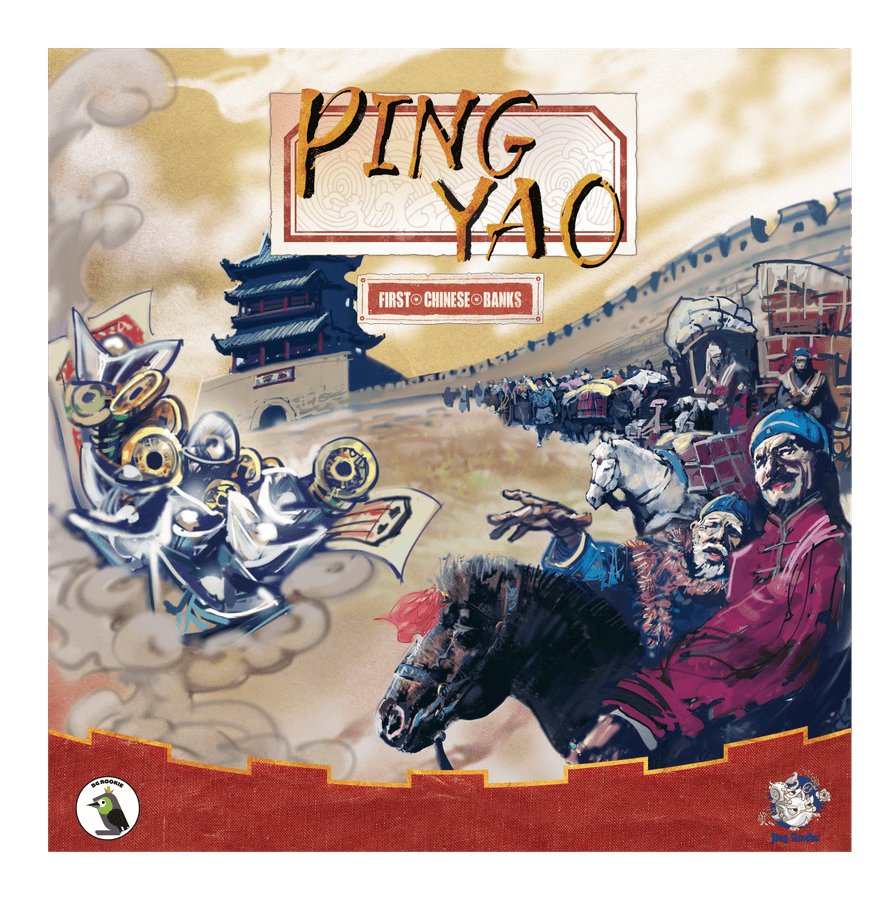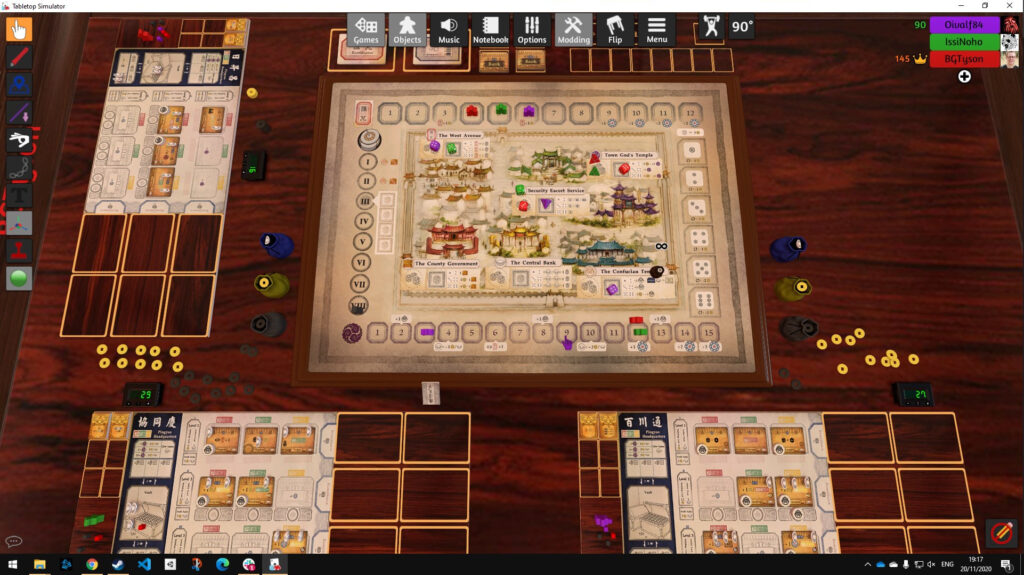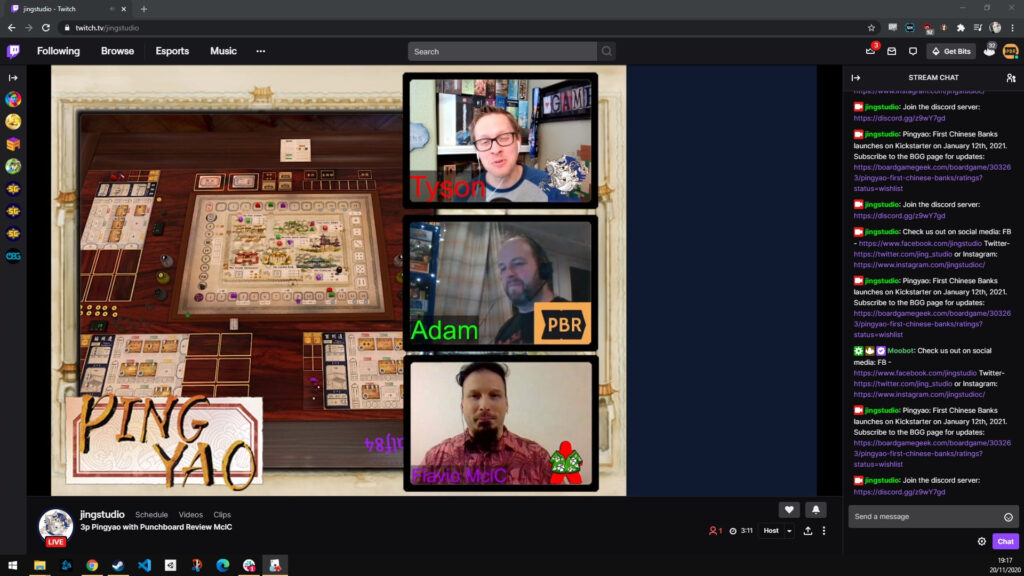Pingyao: The First Chinese Banks is getting a release in English through Kickstarter in January, and I joined the publisher for an online playthrough. Here’s how it went.

Background
I’d seen some really pretty pictures doing the rounds. Pictures of a Euro game with colourful dice for workers, which really piqued my interest. I reached out to the publishers, Jing Studio, and they were kind enough to invite me to an online game. So this Friday just gone, I joined Tyson from Jing Studio and Flavio from Il Meeple Con La Camicia to learn and play the game.
The Game
We played on Tabletop Simulator, but there was no scripting, so the game we played is functionally the same as the physical version.
The Concept
There’s quite a lot of background to Pingyao. It recreates the first steps of banking in ancient China, and has the players establishing their banks in Pingyao city itself, then expanding them through the opening of agencies, taking on remittances, and investing the the silver ingots of the time, Sycee.
You do this by rolling dice and placing them on spots on the board, with the value of the dice determining what you can do at each worker spot.

Gameplay
When the players roll their dice, they all get put on a track which has a communal space for each value. So all of the rolled sixes sit together, the fives, and so on. Dice get placed from these spaces to the board in descending order, and if there are more than one on a space, they’re taken in turn, starting with the first player.
The highest value dice get placed first, but have the least effective power when placed in a spot. For example, when using the Security Service space a 5 or 6 value dice can only open a level one agency, a 3 or 4 can open a level two or level one agency, whereas a 1 or 2 die can open a level three, two or one. But in placing these dice, you also block other players. To unseat your dice, they have to have a die of a different value, and if it’s a lower value (therefore more effective), they have to pay the value difference in coins. There’s another interesting mechanic where when it comes to placing your die, you can pay a coin or two to re-roll it, and still place it then even if the value is now lower, and therefore more powerful. It’s a great gambling feature, and Pingyao is the first game I’ve played with it.
To begin with there are only four spaces available, to place workers. In the third round, two more open up, and each player gains an additional worker. Despite the relatively small number of places to go (in terms of a modern worker placement game), because there are three levels of action on each space, every turn feels like a really tricky choice.

Added to this, there’s the fact that one of your dice is a Grand Manager one. This is a four-sided die, and arguably the most important of the lot. Because it can never roll a five or six, it’s always powerful. And if you do roll a four with it, the chance when you pay for a re-roll of getting a lower number (lower is better, remember) is 75%.
Understanding Theme
I’ll admit that when I first glanced at the rule book, I balked. It seemed daunting and steeped in banking terminology, which sounded like it required an underlying understanding knowledge. Maybe that’s something that might get friendlier when the Kickstarter launches, I don’t know.
However, once our host, Tyson from Jing Studio, explained it more, things made more sense. The essence of this game mirrors the very basics of running banks – who’d have thought?! Silver ingots – Sycee – are the resources players need to get more of. You need them to carry out various actions, and to make money during the game. For example, opening a level one agency (another bank) requires placing two sycee on the new agency. You can give loans from your vault, which earn you interest (more money) each turn.

Where the theme really struck home for me was when I understood remittance. One of the actions lets you take a remittance card and add it to your player area. Taking a remittance in Pingyao is the equivalent of transferring money across ancient China safely. Instead of actually transporting the silver, which was risky, the person could take a remittance which basically says ‘I have xx money in the bank in this other city, and they say I can withdraw it from your bank in this city’. The way this works in the game is that when taking the card you add a sycee from the supply to one of your banks (potentially gaining you more money during the income phase), but on the proviso that once the remittance card moves off the bottom of your area (it moves down one step per round), you promise to remove one from a chosen branch. So the customer has deposited the money in one branch, travelled, then removed it from another. You get money for processing (taking) the remittance, as well as any interest earned while it sat in your bank.
Makes sense, right?
All of the actions in Pingyao are like this – thematically sound, and accurate. And it really adds to the game.
What About Fun?
If you’re a Euro game fan, you’re probably used to dry themes. Heck, I revel in them. That said, I didn’t know what to expect from a game about banking. As it happens, my doubts – and yours for that matter – can be put to one side. This game is Awesome (yes, capital A). Victory points are hard to come by, so even just securing another one or two feels like a big win. Flavio and I had the idea of the game in a couple of turns, and after that we were able to enjoy the tactical decisions without ever needing to look at the rule book.
That speaks volumes for how well designed this game is. It’s a heavy game, make no mistake. I know we were taught, and I know we played online, but it still took us three hours to play eight rounds. But once we knew the gameplay concepts, and what we were trying to do, we honestly only referred to the rules twice I think, and that was just for Tyson to refresh his memory on a couple of edge cases we asked about. Compare that to the last heavy Euro you learned, and see how it compares.

By the time we’d finished – and I don’t like to brag, but I won! – we had all had a great time. Every decision is meaningful, and while there’s no take-that element, there’s still plenty of interaction in terms of blocking spaces, or at least making those spaces more costly for the next person. The theme is sound, the rounds play smoothly and easily, and it’s just a really enjoyable game. I know I’m already waiting for the Kickstarter to launch in January, and I will be backing it. This isn’t sponsored or anything like that. No-one has asked me to write this. It’s just a game I feel strongly about, and I’d like others to take the leap of faith and try it too. The mod is available here on the Tabletop Simulator workshop, so give it a go.
